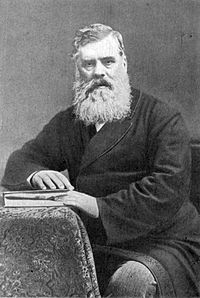Thomas Oldham facts for kids
Quick facts for kids
Thomas Oldham
|
|
|---|---|

Thomas Oldham
|
|
| Born | 4 May 1816 |
| Died | 17 July 1878 (aged 62) |
| Known for | mineral Oldhamite |
| Scientific career | |
| Fields | Geology |
Thomas Oldham (born May 4, 1816, in Dublin, Ireland – died July 17, 1878, in Rugby, England) was an important Anglo-Irish geologist. He made many discoveries about rocks and fossils. He is especially known for his work in India, where he helped start the Geological Survey.
Contents
Early Life and Discoveries
Thomas Oldham went to Trinity College, Dublin. He also studied civil engineering and geology at the University of Edinburgh. There, he learned from a famous geologist named Robert Jameson.
Working in Ireland
In 1838, Thomas Oldham joined a team mapping Ireland's land. He worked as a chief assistant under Joseph Ellison Portlock. Portlock was very impressed with Oldham's intelligence and hard work.
In 1840, Oldham made an exciting discovery near Bray. He found strange, fan-shaped marks in the rocks. He showed them to Edward Forbes, a scientist who studied ancient life. Forbes named these marks Oldhamia after Thomas Oldham. For a while, people thought these were the oldest fossils ever found!
Becoming a Professor
Oldham became the Curator for the Geological Society of Dublin. In 1845, he took over as the Professor of Geology at Trinity College, Dublin. His work was recognized when he became a Fellow of the Royal Society in 1848. This is a big honor for scientists.
Adventures in India
In 1850, Thomas Oldham married Louisa Matilda Dixon. Later that year, he left his job in Ireland for a new adventure. He became the very first Superintendent of the Geological Survey of India. He was one of many Irish geologists who went to work in India.
Mapping India's Resources
In India, Oldham led a huge project to map the country's geology. His team focused on finding areas with coal, which was very important for energy. They made many major discoveries.
For example, Henry Benedict Medlicott named the "Gondwana Series" in 1872. This name is still used today for a group of rock layers.
Family Contributions
Thomas Oldham's family also made important scientific contributions. His older son, Richard Dixon Oldham, studied earthquakes. After the huge 1897 Assam earthquake, Richard identified three types of waves that earthquakes produce. These are now known as P-waves, S-waves, and L-waves. In 1906, Richard also suggested that the Earth's core is liquid, which was a groundbreaking idea!
His younger son, Henry Yule Oldham, became a geography expert at King's College, Cambridge.
Documenting Fossils
Thomas Oldham also started a special publication called Paleontologia Indica. This was a series of books about the fossils found in India. To help with this big project, he brought in a talented scientist named Ferdinand Stoliczka from Europe.
Later Life and Legacy
In 1876, Thomas Oldham retired from his position in India due to poor health. He moved back to Rugby, England. For his many important contributions to geology, including his work on Palaeontographica Indica, he received the Royal Medal from the Royal Society. He passed away on July 17, 1878.

